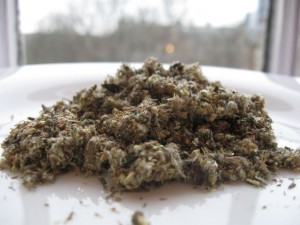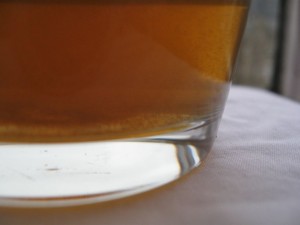Last updated: March 25, 2013
Mugwort tea is a caffeine-free herbal infusion made from the leaves of the mugwort plant (Artemisia vulgaris).
Mugwort grows naturally all over Europe. It’s a tall plant with long, dark green leaves.
Mugwort is in the same genus (Artemesia) as wormwood, the herb traditionally used to make the alcoholic drink absinthe. Because wormwood has an ill-deserved reputation as a mind-altering herb, it’s common to see mugwort described as having similar psychological effects. In fact, there’s no medical evidence to suggest mugwort has any effect on the mind whatsoever. The leaves are eaten as a salad vegetable in many parts of the world. It also has a long history of use as a herbal medicine in Europe and Asia.
Appearance
Mugwort tea is soft and cottony. The color is is grey-green ranging to yellow. The aroma of the dry tea has a little funk and some sharpness.
How to make mugwort tea
- Heat water to a boil.
- Use 1 or 1.5 heaped teaspoons of mugwort for each cup of water.
- In a teapot or french press, pour the water over the tea.
- Cover and leave to infuse for 8-10 minutes.
- Strain out the mugwort and serve.
Drinking mugwort tea
The tea is a deep brown or amber with lots of fine sediment suspended in it. The tiny particles hang almost motionless in the tea as I swirl it around my glass. They make the tea look thick and rich.
After infusing for 5 minutes, the aroma of the tea is moderately sweet with notes of hay and oats, perhaps mildly toasted.
The taste of the tea has a good amount of sweetness with a mellow, well-rounded flavor of subtle aniseed. It reminds me a little of meadowsweet tea. It also pleasantly evokes strong nettle tea with a background of gentle spice.
Mugwort tea infused for 10 minutes has the same aroma but a more developed taste: sweeter with the floral notes of a good honey.
The most surprising thing about the tasting was that at no stage did the tea taste even slightly bitter. As a result of the family connection to wormwood, I had assumed mugwort would be aggressively bitter. In fact it’s mellow with some pleasing delicate high notes of flowers and spice.
Benefits of mugwort
Although traditionally one of the chief mugwort uses has been as a herbal medicine, no modern medical trials have been conducted on mugwort. It hasn’t been confirmed to have any medical benefits.
Side effects of mugwort
Mugwort contains a naturally occurring chemical called thujone which can be toxic at high doses. Don’t be too alarmed; thujone is also present in the commonly consumed herb sage (sage essential oil is approximately 1/4 thujone1). There’s no indication the thujone content of mugwort is radically higher than that2, so it seems mugwort is no more dangerous than sage when taken at a normal dose.Caution should be observed when consuming large amounts of mugwort tea or drinking it over a prolonged period.
In nature, mugwort pollen is one of the most common triggers of hay fever (allergic rhinitis)3. Anyone who suffers from hay fever or other plant allergies should exercise caution when coming into contact with mugwort.


